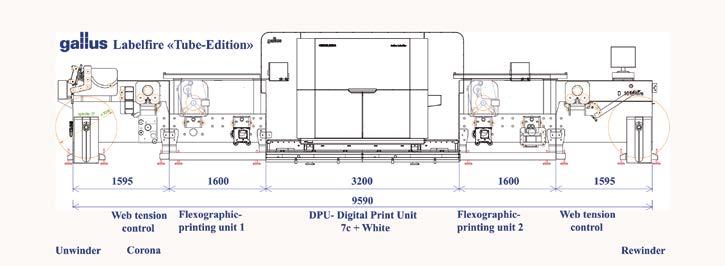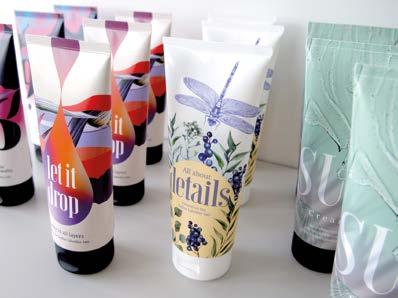
7 minute read
High-Precision Engraved Printing Rools
Superior Ink Release
The final step to Praxair Surface Technologies’ (PST) precision anilox roll process is laser engraving. We take extensive measures to ensure high quality and precision throughout the process. Each characteristic remains within your tight specifications to ensure smooth and consistent ink release. Our technology and process control afford you the choice between two unmatched families of anilox rolls -- ProLine ™ and NovaLine ™ -- each offering superior performance based on your critical requirements.
Advertisement
Proline™
Having the proper cell volume and structure is necessary for accurate color reproduction. PST can verify consistent cell volume because we use the latest process measurement technologies.
Most popular patterns in use today. Transfers ink to the plate easily producing uniform structures. Cell angle does not interfere with plate angle.
The SLR engraving process is highly resistant, this technology is part of the standard 60° engraving, so it does not require any transfer tests and does not require changes in the printing machine setting. Switching to SLR is simple and immediate.
ISF engraving (Ink Spitting-Free) is effective in preventing spitting. The use of channel engraving allows the ink to flow within the engraved channel across the anilox surface, decreasing the ink build-up and hydraulic pressure of the blade.
The Helical engravings open structure offers a much better release for the gravure and coater applications. Optimizes the use high viscosity materials, and high volume capacity operations.
Novaline™
Novaline™ series engravings are obtained using the latest laser technology, where the beam is deflected and modulated at high speed to create a digital definition of each cell.
UV Gold engraving has a very low ratio between volume and cell depth, making it suitable for highly viscous (UV) inks. It is extremely easy to clean. Maximum achievable volume for a given screen count is increased by 20% to 30%.
NovaSilver increases the print density by 10% without any specification changes. Rolls perform at optimal levels, and are highly efficient, even on highly absorbent substrates. The structured engraving holds well with use, and improves ink release when using water-based inks.
ARTGold imprints using the Anilox Reverse Technology (ART), raising “pins“ between the cells. Initially designed for flexographic printing, it has become a standard for offset coating and for laying water-based and UV adhesives and coatings. It is perfect for high opacity white ink.
TIFG engraving allows for a superior high density ink lay-down. Good for high-viscosity materials. The helical grooves create a pattern which allows the doctor blade to run. The continuous channels in the engraving allow the coating materials to permanently flow.
2011/65UE e all’elenco EUPIA per determinate materie prime, nonché bisognava dimostrare l’assenza di sostanze cancerogene, effetti mutageni o reprotossici. L’inchiostro inkjet UV sviluppato e chiamato “UVF01” ha superato i test ed è stato approvato per la produzione commerciale di astucci pieghevoli del produttore del marchio dall’inizio di quest’anno. Ciò ha fornito i prerequisiti per trasferire questi risultati ottenuti per la stampa degli astucci pieghevoli a quella dei tubetti in laminato.
Modifiche Del Sistema Di Stampa
Sono state necessarie modifiche alla Gallus Labelfire 340 per utilizzare l’inchiostro UVF01 relative alla tecnologia di essiccazione e alla guida del nastro. Quest’ultimo doveva prevedere percorsi il più possibile brevi per questo tipo di supporto così costoso.
Gallus ha aperto nuovi orizzonti nel sistema di essiccazione. Nella versione della Labelfire concepita per il
La configurazione della Gallus Labelfire “Tube-Edition” con un gruppo stampa centrale per la stampa digitale inkjet UV con altri due gruppi stampa flexo a monte e a valle / The press layout of the Gallus Labelfire “Tube-Edition” shows the centrally located UV inkjet digital printing unit DPU with an upstream and a downstream flexographic printing unit. (Source: Gallus Ferd. Rüesch AG)
Industrial UV inkjet takes the hurdles out of printing tube laminates
PRINTING ON TUBE LAMINATES USING UV INKJET POSES SEVERAL APPLICATION-SPECIFIC CHALLENGES. THE TUBES, WHICH ARE BENT AND CRUSHED DURING SQUEEZING, REQUIRE A FLEXIBLE INK FILM. IT MUST ADHERE WELL TO THE SUBSTRATE, MUST NOT CRACK DURING HANDLING AND MUST MEET ALL COMPLIANCE REQUIREMENTS. IN ADDITION, THE COST-INTENSIVE SUBSTRATE REQUIRES A MACHINE CONCEPT THAT INCLUDES THE SHORTEST POSSIBLE WEB PATHS AS WELL AS THE OPTION OF PRINT FINISHING.
Some well-known laminate printers entrusted Gallus Ferd. Ruesch AG with this development. The printing press manufacturer was able to adopt some of the solutions for the complex task from the results of another development project. On folding cartons, where the solids extend beyond the ink edges, there are comparable requirements for the flexibility of UV inkjet inks as for tube laminates. The challenge lies in preventing the UV inkjet film from cracking under mechanical stress. For a long time, the only way to avoid cracking of the brittle ink film was to avoid solids that extended beyond the folds by necessity in the packaging design.
Development Of A Flexible Uv Inkjet Ink
For this reason, Gallus launched the “Flexible UV Inkjet Ink” project for folding carton printing along with a well-known brand manufacturer at the start of 2019. The complex development project took three years to complete, including all the development steps, suitability tests and six months of ink qualification. For product qualification, the brand manufacturer printed more than 900 km of board on a Gallus Labelfire 340 and produced around 8 million blanks. The requirement criteria in printing were for the ink film to be fully cured at a printing speed of 70 m/min and for a scratch-resistant, flexible ink film. In the packer test, blanks printed over the entire surface had to be able to be processed at 1,000 packs/minute without ink cracking. In addition, the UV inkjet printing ink had to pass the sensory test programme in the tobacco sector and fulfil all the requirements in the Regulatory Compliance & Toxical Assessment. This included the composition of the UV inkjet ink according to Swiss Ordinance requirements, the REACH conformity test for chemicals, the requirements of the RoHS Directive 2011/65EU and the EUPIA exclusion list for defined raw materials as well as proof of freedom from substances with carcinogenic, mutagenic or reprotoxic effects. The UV inkjet ink system developed in the project with the product name “UVF01” passed the tests and has been released for commercial production in the brand manufacturer’s folding box production since the beginning of this year. This provided the prerequisites for transferring the results of flexible UV inkjet inks from folding carton printing to the solution approach for tube laminates.
Modifications Of The Printing Press System
Modifications to the Gallus Labelfire 340 were necessary to use the UVF01 ink system. These related to the drying technology and web guide. The latter had to be designed for the shortest possible web paths for the cost-intensive substrate.
Gallus has broken new ground in radiation curing. In the Gallus Labelfire version for the new flexible UV ink system, UV-LED curing systems replace the mercury vapour lamps previously used. The advantage of UV-LED nuovo inchiostro UV flessibile, i sistemi di polimerizzazione UV-LED sostituiscono le lampade ai vapori di mercurio precedentemente utilizzate. Il vantaggio della tecnologia UV-LED è che l’energia penetra più efficacemente negli strati di inchiostro grazie all’elevata intensità dei raggi UV-A, garantendo una polimerizzazione più uniforme. A causa dell’elevata intensità dei raggi LED UV, è possibile rinunciare all’uso di booster per ottimizzare l’essiccazione. Ciò significa che i tubetti in laminato sensibili alla temperatura possono essere lavorati senza effetti derivanti dal calore. Come misura aggiuntiva, viene utilizzato gas inerte per l’essiccazione rapida e completa dello strato di inchiostro, durante la quale la reticolazione dello strato di inchiostro nelle camere inerti avviene in assenza di ossigeno, che è stato sostituito dall’azoto e il processo avviene in un ambiente sigillato. Il contenuto di ossigeno nelle camere inerti è continuamente monitorato da sensori e mantenuto al di sotto di 500 ppm. Il miglioramento dell’essiccazione e la reattività dei fotoiniziatori si traducono in un’essiccazione completa della pellicola di inchiostro a una velocità di stampa di 70 m/min. Un ulteriore vantaggio è che si ottiene un’ottima adesione dell’inchiostro al supporto senza l’uso di primer. La configurazione della macchina della Gallus Labelfire modulare “Tube Edition” è stata progettata per mantenere il percorso del nastro nella macchina il più breve possibile. Pertanto viene utilizzato un solo riavvolgitore singolo al posto del doppio riavvolgitore. Nella scelta delle unità di stampa flessografica, l’azienda ha optato per la serie Gallus ECS. Il vantaggio principale di queste unità di stampa è che hanno un percorso del nastro technology is that the energy penetrates the ink layers more effectively thanks to the high intensity of the UV-A beams, resulting in more uniform curing. Due to the high intensity of the UV-LEDs, the use of boosters to intensify drying can be dispensed with. This means that the temperature-sensitive tube laminate can be processed without heat effects. As an additional measure, inert gas is used for fast and complete curing of the ink film wherein cross-linking of the ink film in the inert chambers takes place in the absence of oxygen, which has been replaced by nitrogen in the sealed environment. The oxygen content in the inert chambers is continually monitored by sensors and kept below 500 ppm. The increase in curing performance achieved, as well as the reactivity of the photo initiators result in complete curing of the ink film at a printing speed of 70 m/min. An added benefit is that a very good adhesion of the ink to the substrate is achieved without the use of primers. The machine layout of the modular Gallus Labelfire “Tube Edition” was designed to keep the web path in the machine as short as possible. Therefore only a single rewinder is used instead of the double rewinder. When selecting the flexographic printing units, the company opted for the Gallus ECS series. The main advantage of these printing units is that they have an ultra-short web path of just 1.1 metres from printing nip to printing nip, which significantly reduces waste during makeready and production. Given the high material costs of tube laminates, this is a major factor contributing to high profitability in the printing process. For example, the web path between unwinding and rewinding on the “Tube-Edition” is only around 25 m, compared to around 80 m on a comparable press for tube laminate printing. What’s more, the servo-driven Gallus ECS printing units allow for maximum substrate flexibility when using different thicknesses of laminates. The press layout of the Gallus Labelfire “Tube Edition” features the centrally arranged UV inkjet digital printing unit DEU, with an upstream and a downstream flexographic printing unit.










